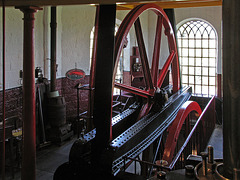tarboat's photos with the keyword: cromford and high peak railway
Transshipment
| 21 May 2020 |
|
|
Southern end of the transshipment warehouse at the terminus of the Peak Forest Canal in Whaley Bridge. It is listed Grade II*.
The first warehouse at the head of the Whaley Bridge Branch of the Upper Peak Forest Canal was built in 1801 and it is attributed to Thomas Brown who was the Resident Engineer for the construction of the canal. This was a three-storey building of gritstone construction positioned at 90 degrees to the canal. It was five bays wide with the central bay straddling the canal. There was an arched shipping hole in the central bay that permitted two boats to enter, side-by-side, so that they could be loaded and unloaded undercover.
The potential of the Peak Forest Canal was considerably enhanced when it became the northern terminus of the Cromford and High Peak Railway in 1831, offering a route for Midlands carriers from the Cromford Canal to reach Manchester and the North West via the Peak Forest Canal. The capacity of the 1801 warehouse was adequate for effective day-to-day operation until the railway brought about a considerable increase in traffic for the Peak Forest Canal at Whaley Bridge and it was deemed that the existing storage facilities were no longer adequate and neither was there a connection with the railway. Consequently, it was decided to increase the storage capacity and make a railway connection by adding an extension of gritstone constructionto the original building.
The extension was built in 1832 and a stone tablet over the central bay of the south elevation, is inscribed with the date, '1832'. It was built by Manchester contractor David Bellhouse Junior.
The Ordnance Survey map of 1875 shows the railway approaching the north and south elevations of the warehouse on the east side. However, this was later changed to a single-track line entering the western bay of the extension through a doorway in the south elevation. This line had a curious arrangement in that it did not provide direct access from the main railway line. Rather, it curved in from the siding of the Bingswood Print Works and an amount of shunting by horses would have been required before waggons from the main line could enter the warehouse. A possible explanation for this arrangement is the possibility that a considerable amount of goods associated with the print works were carried on this line.
The original 1801 warehouse and the 1832 extension remained intact until 1915 when, for reasons now lost, the top floor of the warehouse was removed. The remaining north, east and west elevations of the original building were then re-modelled and re-roofed to match the 1832 extension.
The water feed from the Toddbrook and Combs Reservoirs reaches the canal through the warehouse, emerging from a culvert behind the metal fence.
Thanks to Peter Whitehead for the information.
Turning triangle
| 13 May 2020 |
|
The Cromford and High Peak Railway which wound its way through this area via sharp curves and the use of a number of inclines up which the wagons were hauled by stationary steam engines. On the opening of the Buxton to Ashbourne railway some sections were incorporated in the new line whilst others were abandoned. Here at Hindlow the new line passes through a tunnel and the old alignment is left at a higher level. On this section are the remains of a triangular section of the original railway which was used to turn wagons so that their end door was facing uphill when being run on the inclines.
Curves
| 22 Jan 2015 |
|
|
When the Cromford and High Peak Railway opened in 1831 it was operated with horses between the inclines and the tight curves were not a problem. After the introduction of locomotives this curve on the approach to Burbage tunnel must have caused significant difficulties and a new alignment (on the right) was created, which required a significant embankment to be built. It is a bleak place, even in summer, and must have been a hard place to work.
Middleton Top
| 15 Jul 2010 |
|
The double single cylinder beam geared haulage engine at Middleton Top was built in 1829 by the Butterley Company to wind wagons on the 708 yard Middleton Incline on a gradient of 1 in 8.25. The winding cable ran around the large central wheel being driven by a gear wheel below. The incline was closed in summer 1963 and the engine is now in the care of Derbyshire County Council. On some open days it is run using compressed air.
Beam end
| 28 Aug 2008 |
|
One of the beams on the two cylinder Middleton Top winding engine on the Cromford & High Peak Railway.
Middleton Top
| 04 Aug 2008 |
|
I noticed that the Middleton Top enginehouse was open yesterday and when I arrived there were no other visitors inside, which allowed me plenty of time to take photos and to talk to the very knowledgeable warden.
The double single cylinder beam geared haulage engine was built in 1829 by the Butterley Company to wind wagons on the 708 yard Middleton Incline on a gradient of 1 in 8.25. The winding cable ran around the large central wheel being driven by a gear wheel below. The incline was closed in summer 1963 and the engine is now in the care of Derbyshire County Council. On some open days it is run using compressed air.
Jump to top
RSS feed- tarboat's latest photos with "cromford and high peak railway" - Photos
- ipernity © 2007-2025
- Help & Contact
|
Club news
|
About ipernity
|
History |
ipernity Club & Prices |
Guide of good conduct
Donate | Group guidelines | Privacy policy | Terms of use | Statutes | In memoria -
Facebook
Twitter






